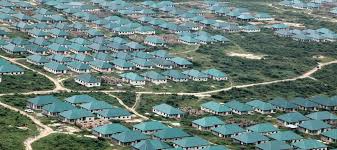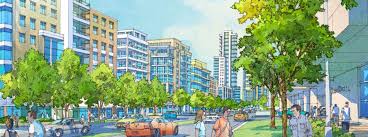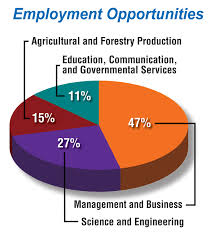A Holistic Approach; to the post war development plan of Borno State the commercial centre of North eastern Nigeria.

The process of reconstruction involves partial or complete relocation and rebuilding the essential physical infrastructure and shelter (house) so that vulnerability levels are reduced and families are able to get back to their feet. Reconstruction therefore paves the way for long term rehabilitation.
Rehabilitation primarily addresses the new or increased poverty levels that have emerged due to the disaster. Jobs and income generation measures in the construction sector provide an immediate and emergency boost to the local economy. This is followed by long term improvement in land and water management and economic opportunities that seek to upgrade local economies and reduce community vulnerability in a sustainable manner.
For the process of sustainable development to take off in continuation with reconstruction, it is important that the end objective is not limited to only getting people back upto the base line levels prior to the man made or diaster. The intervention over a longer term should resultant improved quality of life and reduced levels of vulnerability. While families are tuned to picking up the pieces of their life, concepts of improved building practices, sanitation, sewerage, rainwater harvesting, improved land, water management, improved mechanized agriculture and its value chain industries, etc. can be gradually introduced.

It is reported in other places, where development activities of improved shelter, land and water management and livelihoods were in progress at the time of the war, not only was the loss of property and life minimal, and the loss in economic time. People could bounce back easily very soon after the disaster. This is a very strong argument in favour of “total rehabilitation” as opposed to only reconstruction.
Reconstruction and rehabilitation need to be in a seamless continuum with restoration efforts. The issue of correct timing and speed is however, significant. A holistic approach does not negate the need for a fast response to immediate reconstruction.
Time and again it has been seen that people will revert back to their
earlier unsustainable practices very soon if timely inputs are not made and systems that ensure long term continuity of material and skill availability are not set in place.
From Reconstruction to Rehabilitation, the reconstruction of shelter and community infrastructure, in fact, forms an important entry point for the rehabilitation process.
A reconstruction program is the first step towards restoring and
upgrading local habitat. It introduces improved systems of building,
sets up basic building element supply, builds up the skills and
management capacity of families, local agencies and village artisans in a restricted area and sets up local information and knowledge systems. All these to enable “better building”.
A holistic view of “Habitat” that links the process of housing with the capacity to make and exercise informed choices building
construction, habitat improvement and economic betterment is the larger goal.
Re-establishing people’s lives through rehabilitation efforts involves:

- Moving up the ladder from house to habitat to livelihood
- Local awareness creation including training for all so that people gain control over the housing process.
- Capacity Building and linking to enterprises-Livelihood support
- Devising livelihood interventions in the farm and non-farm sectors based on new economic opportunities to create economic surpluses (that can be directed to responsive housing)
- Creating a basis for community access to institutional housing
finance
A response strategy – facilitating the creation of Sustainable
Livelihoods. A effective response strategy is to understand the need for building materials, buildings and livelihoods and catalyze the conversion of this need into demand. The demand for (sustainable) building technologies and construction practices can be provided through sustainable enterprises.
This response strategy addresses the present (immediate) need of
reconstruction through local building technology-based enterprises. Reconstruction activities, if designed to include local manpower,
provide the essential ( short term) jobs leading to an immediate spurt in the local economy. At the same time, building material and skill based local enterprises ensure continuous supply of quality building materials and skills. In the long term this is likely to result in a sustainable improvement in shelter conditions while also enlarging livelihood options in the region.
The reconstruction program at the outset provides a major advantage to the new enterprises. It forms the initial captive market, provides critical visibility to the new technologies and improved systems of construction and also (if systematically approached) builds up the acceptance of these new “products” in the market. A sensitive reconstruction program will necessarily involve an accompanying process of educating the affected population on the aspects of safer construction; thus inculcating an appreciation of the improved systems. After the initial reconstruction phase, families would preferentially opt for these materials and techniques to extend their houses.
An important aspect here is that new materials and techniques should match the paying capacity of the targeted communities. A multi pronged approach is required here:
First, the selection of the improved technologies and construction
systems should bear in mind the long-term affordability of the affected population. This involves correct selection of raw materials, production processes and scales of delivery. An optimum combination of large industry based materials and village enterprise based production with materials sourced from regional building centers.
Secondly, a parallel intervention in improving quality of life through
enlarged livelihood options and improved land, water, resource
management practices resulting in enhanced purchasing power within communities.
And, thirdly, interventions of housing and livelihood finance are
required that enable people to access available building options.
These building material production centers or the Building Materials and livelihood Banks (BMLBs) are managed by local NGOs with the production component sub-contracted to local community groups. At present, these centers supply improved building elements, technology and
skills for the ongoing Rehabilitation Program. In the long run, they are envisaged as centers for total habitat guidance to the village community on housing, sanitation, domestic energy, water storage etc. These would be one-stop shops for all local habitat needs including access to housing finance.
The Banks are centralized material production and service hubs at the moment but these are designed to eventually fission into down-scaled building material enterprises to become the nuclei of a large number of decentralized SME units spread throughout the region.
The technology transfer process during the core reconstruction , rehabilitation already facilitating production and based livelihoods. This is designed to introduce new skills and capacity for improved cyclone resistant building systems within the local area in the form of enterprises. These enterprises would continue to build new houses, extend and upgrade old houses long after the immediate reconstruction interventions are over.
The project funds in the short term will lead to the construction of
many infrastructures and set up building material based enterprises; and as investments in livelihoods, capacity building and information
dissemination these would pay dividends by way of
a. Enabled, Informed Communities
b. Enhanced Building Material Supply
c. Improved Economies

1. BASIC CONCEPT – REHABILITATION AND RECONSTRUCTION
To be continued


